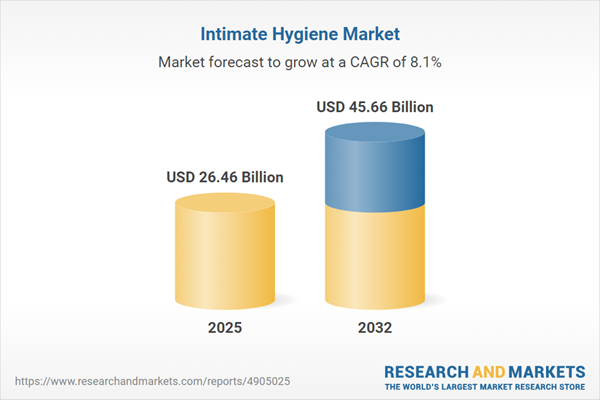Speak directly to the analyst to clarify any post sales queries you may have.
The intimate hygiene market is undergoing a rapid transformation as personal wellness trends and evolving consumer behaviors reshape industry priorities. As demand for specialized, effective, and transparent solutions grows, businesses face new opportunities—and challenges—for growth within this crucial segment.
Market Snapshot: Intimate Hygiene Market Size and Growth
The intimate hygiene market grew from USD 24.45 billion in 2024 to USD 26.46 billion in 2025 and is expected to continue growing at a CAGR of 8.11%, reaching USD 45.66 billion by 2032. This expansion is driven by rising awareness of personal well-being, continued innovation in product formulations, and changing regulatory landscapes. Key players, evolving consumer demography, and advanced digital sales channels collectively accelerate the sector’s trajectory. Stakeholders are now prioritizing both customer health and sustainable business models.
Scope & Segmentation
This comprehensive report covers a wide spectrum of the intimate hygiene landscape, with specific attention to market structure, emerging technologies, and the impact of regional regulations. The report provides clear segmentation, ensuring actionable insights for targeted portfolio management and optimized go-to-market strategies.
- Product Form: Creams, sprays, washes (including foam and gel formats), and wipes—both biodegradable and non-biodegradable.
- Sales Channel: Offline channels such as pharmacy, specialty retail, and supermarkets/hypermarkets; online platforms including direct-to-consumer and e-commerce outlets.
- End User: Adult men, adult women, and teenagers, addressing distinct hygiene needs and communication strategies.
- Ingredient Type: Formulations based on natural, organic, and synthetic ingredients to meet varying consumer and clinical demands.
- Gender Segment: Men, women, and unisex product positioning tailored for targeted marketing and expanded reach.
- Regional Coverage: Americas (including North and Latin America), EMEA (Europe, Middle East, Africa), and Asia-Pacific, with insights into key country-level performance and regulatory requirements.
- Company Analysis: Includes competitive and strategic developments across leading global companies in the sector.
Key Takeaways for Senior Decision-Makers
- Consumer preferences are shifting toward gentle, transparent, and science-backed solutions, reflecting growing health consciousness and an expectation for ingredient clarity.
- Advances in delivery systems, such as new wash formats and biodegradable wipes, enable tailored experiences that address pH, sensitivity, and on-the-go needs.
- Omnichannel distribution is critical, as digital platforms for education and subscription models complement traditional retail and pharmacy environments.
- Sustainability and regulatory compliance are not optional—eco-friendly packages, clean formulations, and robust labelling standards are now baseline expectations.
- Collaboration with healthcare professionals and influencers fosters trust, supports product validation, and accelerates market acceptance.
- Regional and demographic nuances drive the need for differentiated strategies, with emerging opportunities particularly apparent in digitally advanced and demographically dynamic territories.
Tariff Impact: Navigating 2025’s Regulatory Landscape
The 2025 tariff adjustments in the United States have introduced new challenges to intimate hygiene supply chains, influencing costs for raw materials, specialty polymers, and packaging components. These revised duties require strategic sourcing, nearshoring, or portfolio diversification to manage cost pressures. Many brands are reevaluating vendor relationships, negotiating logistics, and introducing new pricing strategies—such as multipacks and volume incentives—to protect margins and maintain stability. The evolving tariff framework also catalyzes innovation in supply chain resilience, promoting the formation of strategic partnerships and investments in adaptive manufacturing processes.
Methodology & Data Sources
This report is underpinned by a structured research approach. Secondary research included a comprehensive review of industry publications, regulatory documents, and scientific literature. Primary insights were gathered from interviews with industry experts and consumer surveys across demographic groups. Quantitative and qualitative data were synthesized to ensure the accuracy and actionability of the analysis.
Why This Report Matters
- Empowers strategic planning by providing granular segmentation and key competitive intelligence across core product types, user demographics, and regions.
- Supports risk mitigation and opportunity recognition through analysis of evolving tariffs, regulations, and sustainability standards.
- Guides investment, innovation, and partnership strategies by highlighting emerging trends and actionable takeaways for senior leaders.
Conclusion
The intimate hygiene industry is evolving rapidly as consumer wellness, innovation, and responsible business practices converge. Informed decision-making, regional adaptation, and resilient supply chains will define the next stage of market leadership. This report serves as a decisive tool for shaping strategies that align with industry transformation and stakeholder expectations.
Additional Product Information:
- Purchase of this report includes 1 year online access with quarterly updates.
- This report can be updated on request. Please contact our Customer Experience team using the Ask a Question widget on our website.
Table of Contents
3. Executive Summary
4. Market Overview
7. Cumulative Impact of Artificial Intelligence 2025
Companies Mentioned
The companies profiled in this Intimate Hygiene market report include:- The Procter & Gamble Company
- Kimberly-Clark Corporation
- Essity AB
- Unicharm Corporation
- Johnson & Johnson
- Edgewell Personal Care Company
- Kao Corporation
- Ontex Group NV
- Sanofi SA
- Medline Industries, L.P.
Table Information
| Report Attribute | Details |
|---|---|
| No. of Pages | 184 |
| Published | October 2025 |
| Forecast Period | 2025 - 2032 |
| Estimated Market Value ( USD | $ 26.46 Billion |
| Forecasted Market Value ( USD | $ 45.66 Billion |
| Compound Annual Growth Rate | 8.1% |
| Regions Covered | Global |
| No. of Companies Mentioned | 11 |









